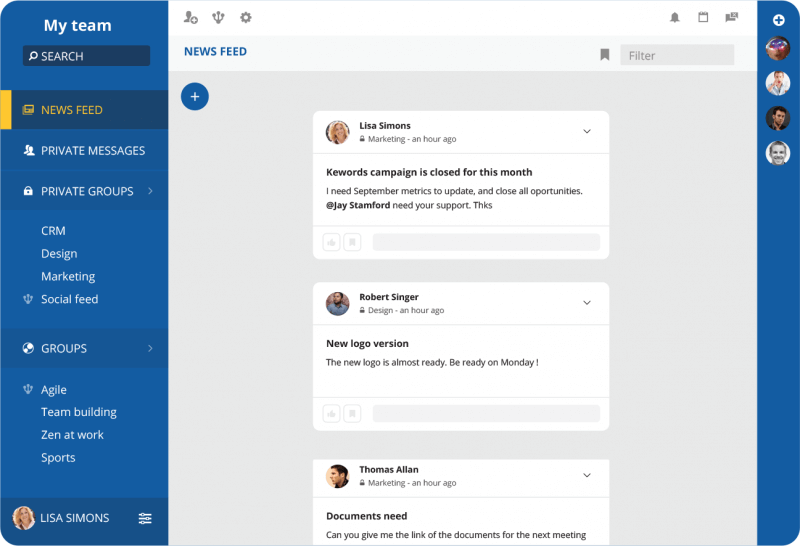The days of being confined to a single work location are dwindling. The nature of work has become more remote and distributed. In 2016, 43 percent of employed Americans said they spent at least some time working remotely, according to a Gallup survey of more than 15,000 adults. Companies are breaking down traditional, structural norms and pushing for flexibility.
Going remote is now a necessity
A big reason for supporting remote work, is that talented workers want it. Having the flexibility to work at home, café or co-working space means workers can organize themselves to suit their personal and family needs.
Another motivation for remote work, is that it has become a necessity. Naturally, people are mobile. Rather than invest resources into continually finding new workers every time someone moves, it’s more affordable to keep that person and let them work wherever they want.
Beyond just retaining talent, supporting remote work is a competitive advantage in attracting talent. Companies can’t restrict themselves to looking in only certain geolocations. For instance, there is an abundance of equally skilled and more affordable skilled software engineers outside of Silicon Valley.
But who is doing remote work and doing it well? Invision, an online design software company, has over 160 people working remotely — and is thriving. GitHub, a major force in software development also many remote engineering roles. American Express has also embraced flexible remote work. These are all examples of companies seeing the benefits of happier and healthier employees from remote work, but the fact is nearly every organization is doing some form of it.
Challenges and consequences of remote work
Of course remote and distributed work doesn’t come without difficulties and challenges. In a professional work setting, some real challenges faced by remote teams are: co-ordinating meetings, clearly understanding each other across different cultures, collaboration and on a more human level, building a strong team culture when people are isolated. The consequences of these problems can be severe.
Although many meetings can be a time suck, some are critical. One of the main benefits of remote work, is the freedom to be mobile. But in order to co-ordinate a meeting between remote people, even the task of coordinating a time can feel like a waste of time. This results in efficiencies and delays in decision-making, thereby slowing down the business.
Especially when teams are distributed around the world, inevitably the team is made up of different cultures and languages. This can lead to misunderstanding or misinterpretation, which can easily result in very costly mistakes or wrong actions being taken.
For remote teams it’s difficult to gather together, brainstorm, give feedback and get started on a project. Without effective collaboration, organizations lack direction and purpose, draining motivation.
A major facet of successful companies is a strong culture. When there is a lack of human interaction, it is extremely challenging to form meaningful bonds. The ability to share the vision of the leadership and direction of the company is also constrained. Without these foundations, an organization can’t grow and mature.
For an organization with remote workers to thrive, it must find a way to face these complex problems and work effectively as a unit. So how do remote teams working across different time zones communicate, organize meetings, collaborate and feel connected, even in an asynchronous way? The answer lies in powerful and well-designed online communication and collaboration tools.
A better way to communicate and collaborate remotely
Think about the types of information you share on a daily basis with your company and team. Important announcements about company structure, funding announcements, awards, key hires, major deals or social events are common.
Email is still a popular medium for disseminating this information. But it wasn’t designed for actual collaboration. Email can often become cumbersome where long conversations turn into excessively long threads. People can’t follow the real intent or decision being made, so people lose interest, disengage or even feel excluded. Email also carries the baggage of email etiquette, where people feel the need to be more formal and guarded since it’s very difficult to retract something after hitting ‘send’.
The better way to communicate remotely is to enable people to mimic the way they naturally express themselves. And that’s what the most successful online communication tools or chat apps of today do. Slack, is one of them with 6 million daily active users. Globally, it has replaced email in many teams and organizations. Users can chat, video call, share files, images and the all important emoji or GIF. This allows people to feel connected and understand exactly what they are talking about, even when they are not together.
The downsides of chat apps
Yet, chat tools by themselves have some shortcomings. Naturally when people chat, they expect instant answers. The constant bombardment of incoming messages and notifications can be detrimentally distracting. In order to be polite and appear responsive or avoid missing out, people feel the pressure to be ‘always on’. This new normal of synchronous communication can actually be unhealthy and unsustainable because it doesn’t reflect reality.
The reality is that people are occupied and should be focusing on the task at hand. People work across time zones, are in meetings, on holidays or simply doing what humans do like sleep. When work communication is all done via chat apps, it makes it really difficult for occupied people to follow or participate in the conversation. Ironically, email actually did a better job of this. With email, people don’t expect an instant reply. This gives people time to think about an appropriate response or simply respond when they are ready.
Perhaps one of the most biggest frustrations of using chat apps like Slack, is that as conversations happen in real-time, different conversations become intertwined, making it difficult to grasp what is happening or if there was a conclusion to something. This happens all the time, even within dedicated channels. This constant context switching can often be inefficient and annoying. Email is actually better at containing a single topic in one email chain.
Talkspirit solves the problem of email and chat apps
So if email is too cumbersome, unnatural and doesn’t help facilitate collaboration and chat apps are too noisy and confusing, what is the best solution?
We believe, the Talkspirit Newsfeed is the right blend of efficient and organised collaborative communication.
Like the Facebook Newsfeed, the Talkspirit Newsfeed shows you all the relevant information you need (without the annoying ads). In one clear overview, you can instantly see personalized news just for you. This means you aren’t overwhelmed with clutter or noise.
To get the most context out of Talkspirit Newsfeed, users leverage the group functionality. This means, if you belong to or follow a specific group, your Newsfeed will be personalized by news from only those groups. Groups are flexible and can be create around anything: topics, departments, projects or events. You are always in control of which groups you join or leave. The Newsfeed, is organized by threaded conversations, making it more relevant rather than bounce from topic to topic. This means you only interact and share relevant information in a clear and neat way that email and chat apps can’t do.
So even if you work remotely, Talkspirit enables you to get the right news and information when you need it, in one easily accessible place. Then, when you’re ready, you can use the chat function to share your thoughts, comments and make decisions quickly.

Ultimately, it is important to realize the inevitable trend of remote working styles. Now, it is your responsibility to prepare for how your company and team operates in remote mode. We believe you don’t have to sacrifice the downsides of email and chat apps to be a highly productive team.
Over the long term, using a tool like Talkspirit to share, consume and collaborate around news will help you scale sustainably.



